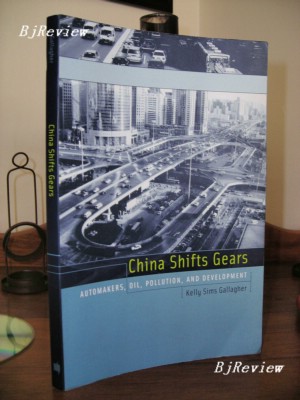
In the classic economic model, there is land, labor and capital. Each plays a role in economic development through its supply, and development cannot occur without input from all three. Modern economies, however, must take into account technology. As capital funds labor and labor generates capital, there is a stalemate in development. Adding innovation allows the process of actual development to occur, breaking the stalemate of cyclical production. In China Shifts Gears, Kelly Sims Gallagher investigates how foreign technology transfers have transformed the Chinese automotive industry, what effect more automobiles have had on the economy and environment, and how technology can be developed to address the environmental effects and further develop the industry.
Each year 1.6 million workers build around 2 million automobiles for Chinese consumers. Collectively, there are over 60 million passenger cars, motorcycles, and light trucks on Chinese roads. In part, the proliferation and increased use of autos have made China a net importer of oil. Though the country's 2.4 million barrels per day (2004) remain significantly below the U.S. level of 10 million (2004), the rate of increase for auto sales was about 40 percent from 2001 to 2002. In a worst-case scenario that assumes paralleled growth, Gallagher predicts by 2020 there will be 840 million autos in China emitting carbon monoxide, nitrogen oxide, and hydrocarbons. Total oil consumption just for autos would increase to 24.8 million barrels per day. In order to avoid the worst-case, Gallagher believes technological development must be put first.
In order to develop its infant automotive industry, in 1984 China welcomed American motor corporation to set up a joint venture (JV) called Beijing Jeep Corp. This JV was successful at first, and its client base was predominantly the military and wealthy individuals. However, little technology was transferred, and workers simply reassembled jeeps that were built and shipped from Detroit, Michigan. In 1994, the Chinese Central Government instituted a strategic new policy that set out to foster a domestic automotive industry through local content quotas, technology transfers, and technical education centers. When Shanghai GM was founded, the joint venture was intended to be a model in which Western technological innovation would help the Chinese leapfrog auto development. While a significant portion of the cars produced by Shanghai GM use over 40 percent of locally produced components, the design and development process has not been transferred. Chang'an Ford's production plant has remained virtually a mechanical manufacturing process as well.
Effecting real technology transfer is a two-fold problem. First, China's environmental standards do not demand enough from the auto industry. While strong pollution controls exist for the kinds of autos sold in China, foreign manufacturers are not compelled to incorporate them in local products. As well, most of this technology relies on heavily refined oil, which did not exist in China during the period researched. Thus, the cars sold in China were only as efficient as the oil that they used was refined. Second, while many manufacturers are interested in developing their business in China, including production and design, much of the engineering process remains in the minds of the engineers.
Recognizing the difficulty China has had in effecting technology transfers, Gallagher suggests the Japanese and South Korean models of development. Her use of Alice Amsden's analysis of development is a clear indication that Gallagher is a proponent of demiurge or corporatism. While this has been a successful model, Gallagher's research shows that foreign auto manufactures are in fact transferring technology through the training of college and university students around China in basic auto design. In any free market, knowledge is the most powerful technology. As well, the Central Government has been keenly promoting stricter pollution controls for autos since 2000, which follow European standards.
Thus, technology transfers are not being stymied by an irrefutable lack of concern by foreign automakers, but through emission regulations, rather than industrial midwifery, the state has just begun creating an environment that actively promotes market-based technology transfers. In 2005, all new cars in China had to meet Euro III emission standards. And as China continues to develop its regulations for automobiles, many foreign firms will be compelled to use their capital to invest in local labor for research and design in order to produce vehicles that meet local standards. Gallagher concludes that such compelling regulations are absent, ignoring a significant portion of her research.
The author is a Political Risk Analyst for Exclusive Analysis, Ltd. and covers the financial industry and regulation in Vietnam, China, and South Korea. He holds a MA in Diplomacy and International Relations with a focus on economic development from the John C. Whitehead School at Seton Hall University
| Kelly Sims Gallagher is Director of the Energy Technology Innovation Project (ETIP) of the Belfer Center for Science and International Affairs at Harvard University's Kennedy School of Government and an Adjunct Lecturer in Public Policy. She has a M.A.L.D. and Ph.D. in International Affairs from the Fletcher School of Law and Diplomacy at Tufts University. Her research interests include energy technology innovation, international energy cooperation, energy policy, climate change policy, international environmental policy, and technology transfer/economic development questions. She has an A.B. in international affairs and environmental studies from Occidental College. Her book, China Shifts Gears: Automakers, Oil, Pollution, and Development, was published by MIT Press in 2006. | |
